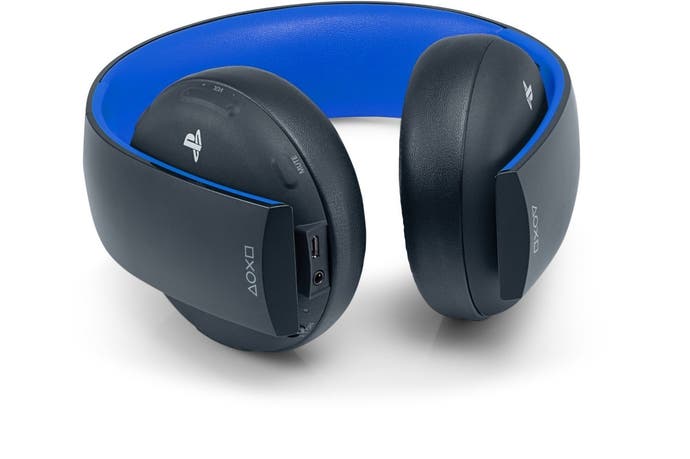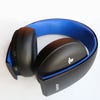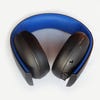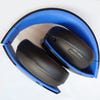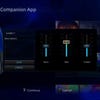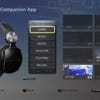Sony Wireless Headset 2.0 review
Digital Foundry takes a look at Sony's official surround sound solution for PS3, PS4 and Vita.
The market for wireless gaming headsets has blown wide open in recent years, with third party brands such as Tritton, Turtle Beach and Astro each offering powerful accompaniments to the online FPS experience. Enter Sony with its first official PS4-compatible offering; an over-ear, noise-isolating, virtual 7.1 surround sound headset with an integrated rechargeable battery. At just shy of £80 it undercuts the competition bearing the same bullet-points - but taking into account its build quality, sound reproduction and features, does it pass muster in practise?
Taking the set out of a no-frills box, the unit itself is a match for the Astro A50 headset in terms of overall size. To suit the PS4 console's own angular, minimalist look, the headset sports a symmetrical design with a fetching royal blue and black motif. It's sleek and simple, with a matte plastic headband and two faux-leather ear-cups that are fully collapsible for travel. As for the microphone, an aperture is discretely built into the left earpiece, meaning there's no need to adjust an extended wire into position every time you play.
Sony's new set is a light fit too, with several notches on either side to adjust for head size. Unlike the Turtle Beach X5 or Astro A50, which cushion the ears with soft nylon meshes and felt, Sony's new headset opts for faux-leather padding. This step away from fabric has a few trade-offs; the main one being that it minimises dust and hair build-up, but with a material at the risk of long play sessions leaving you feeling hot behind the ears. The leatherette material doesn't ventilate nearly as well as other headsets we've tried, but outside of this one drawback, it does help make the set comfortable to wear - and largely transparent during a gaming session.
Also included in the box is a USB dongle, one USB charger cable, a soft carrying case and a 3.5mm jack for connection with the PS Vita (or any other portable device). For PS3, PS4 and PC, wireless setup is as simple as plugging the supplied dongle into a port and switching the headset on. To our surprise, we don't need to follow any elaborate sync-up procedures after that; it takes a moment and after a few flashes of the headset's blue LED it's good to go. For the Vita, the supplied 3.5mm cable lets the headset go direct to the source for stereo-only sound, with extra tracks on the connector allowing for volume controls and the use of its microphone.
Once turned on, another point in the headset's favour becomes apparent: sound isolation. Without putting too much pressure on the ears, as is an issue with the Tritton Warhead 7.1, it successfully blocks out most of Killzone Shadow Fall's gunfire-heavy soundscape, even while at full volume in a quiet living room. Trying to leave the PS4's vicinity with the headset, meanwhile, gives us a few issues with signal in the expected spots. We find two or more walls breaks up the sound with ease, while its 2.4GHz signal just about reaches downstairs levels with a few blips. It's not a massive range, but for gaming in the living room and just beyond, you're covered.
Outside of the USB port and audio out, each cup is lined with rubberised buttons dedicated to the essential controls. There's a volume rocker to the back of the left ear, a mute button, a virtual surround sound toggle (abbreviated to VSS), and a rocker to balance game audio and chat. Working with these blind takes a bit of getting used to, especially since they're almost flush with the mould of each cup, but there's just enough of a groove to each button to pick them out.
Moving around to the bottom of the left cup, we have a power switch which doubles as a selector for equaliser presets - the first being default, while the second's a clean slate that can be manually tweaked. Since there's no PC software to go into minute details here, Sony has wisely made a Headset Companion app available on its SEN store. Through this you can upload a specific 'shooter' preset to this second slot - with options for other game genres such as 'horror' or 'fighter', plus a custom three-band equaliser that can be edited manually with sliders.
Once we're done, we simply connect and upload our setting to the headset via USB. It's a basic tool all told, but provides some flexibility if the default sound isn't tuned to your tastes. In our case, we find the headset's standard focus on mid-to-high range is best suited to videogame audio. Battlefield 4's gunfire sounds are tight, crisp and response is free of distortion during heavy stretches of explosions. Delicate sounds make it through effectively too, such as the rustle of ally players nearby or the first bounces of a frag grenade - particularly with the added boost to treble on the shooter preset. For multiplayer strategists, the microphone sensitivity also proves spot-on, despite being contained within an ear-cup. Though very slightly muffled due to its discrete positioning, in our experience, the sound still comes across loudly and clear enough for team members in The Last of Us.
However, pressing its two 40mm drivers with music does reveal weaknesses in the headset's bottom-end. The crescendo to Dream Within a Dream from the Inception soundtrack lacks the bass punch we hear on other headphones. In fairness, what it lacks in warmth it makes up for in sparkling clarity. Sony's headset has a sound signature that falls close to Sennheisers' more clinical, top-focused sets - it's a great sound, but even with configurations in the Companion app there's only so far you can compensate for the hardware's inherent subtlety in bass.
Support for up to 7.1 virtual surround sound is a high point. However, the effectiveness of its VSS processing is at the mercy of any given game's audio design. Killzone Shadow Fall is the first title we try, and immediately we're frustrated by how quiet the sound mix is by comparison to Battlefield 4's loud and crunchy output. It's too subdued, but switching to small speaker mode in the game's settings helps massively to bring out all the small aural details - and crucially enabling us to pinpoint their point of origin within a 3D space.
"Sony has handed in an accomplished surround solution, marred only by a noticeable lack of bass and the way it gets hot behind the ears after extended gameplay."
The VSS mode must be enabled for this to work, otherwise games suffer from a hard pan when heard through Sony's headset. Put simply, the extra processing puts all surround sound channels into logical positions for a headphone user. For our money, the effect is put to its best use with The Last of Us' superb multiplayer - a slower paced game than the FPS titles we try on PS4. Catching the sneaking footsteps of a saboteur lying in wait, camping behind a supply point with Molotov primed, proves a real life-saver when it's possible to instinctively judge to which angle you should immediately turn.
Where other games constantly barrage you with sound, the stealthy nature of Naughty Dog's masterpiece helps to draw attention to crucial, life-saving details in the sound design. In this sense, Sony's Headset 2.0 ticks this box, but for the best experience the software needs to meet it halfway. Meanwhile, Battlefield 4 serves up a solid alternative for showcasing a virtual 7.1 surround sound mix, despite being a touch on the overwhelming side once the tempo picks up.
Sony Wireless Stereo Headset 2.0: the Digital Foundry verdict
After all is said and done, Sony has concocted an affordable, sleek wireless headset for enthusiasts of its hardware, and much like the PS4 console itself, benefits from a clear focus on gaming - with no bloat to crank up the costs. It might miss the mark for those wanting to spread their surround-sound experience to PC, for example, but the stereo function in that case is a sturdy alternative - and underpinning it all is a bold, crystal clear quality of sound. We're equally impressed that promises of eight hours battery life hold up to scrutiny. Even with volume at maximum we clock just over seven hours total, while recharge times are respectable too, at just under two hours to fill to capacity.
Whether the goal is to isolate the sound from a gaming session or to ramp up your alertness during multiplayer, the headset gets a lot right. Given that most competing headphones with an equivalent feature list go for above the £100 mark, particularly with a rechargeable battery, Sony surprises us with the value proposition here. This is especially encouraging in the face of its other, pricier launch peripherals. By virtue of being the official solution, there are some unique benefits to consider too: the Headset Companion app on PS3 and PS4 being a helpful way to adjust its settings, if a bit ineffective in working around a slightly subdued bass response. It's perhaps a touch light-footed for music with a heavy kick then, but if a surround sound gaming headset is your main concern, this is a very well-rounded package indeed.
